1lumen selects and reviews products personally. We may earn affiliate commissions through our links, which help support our testing.
Imalent MS12 MINI review
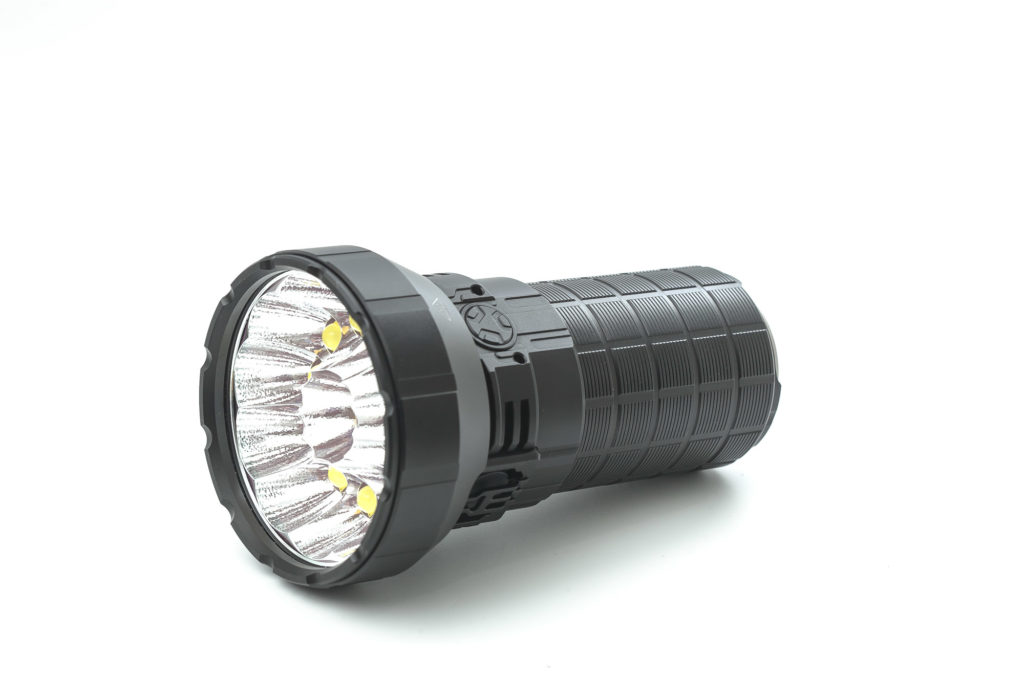
Imalent MS12 MINI specifications
| Brand/model | Imalent MS12 Mini |
|---|---|
| LED | 12* CREE XHP70.2 |
| Max. Lumens | 65,000 lm |
| Max. Beam intensity | 286,600 cd |
| Max. Beam distance | 1036 meters |
| Battery config. | Battery pack (4*21700) |
| Onboard charging | Yes, proprietary 5.5mm dc jack |
| Modes | 6 |
| Blinkies | Strobe, SOS |
| Reflector | Smooth |
| Waterproof | IP56 |
| Review date | April 2022 |
Introduction:
Note: the Imalent MS12 Mini has been updated, andnow includes USB-C charging. Check out our review of the new Imalent MS12 Mini C.
Hey, wait a minute. Didn’t we already review the Imalent MS12? Yep, but this is a newer version, the MS12 MINI, and is way, way, way smaller, and more powerful.
The MS12 Mini replaces the 12*XHP70 in the MS12 for 12*XHP70.2 LEDs. Plus, it replaces a huge battery pack (8*18650), for a short battery pack with only 4*21700 batteries.
At the time of writing, this is the most powerful compact flashlight in the world. It can even fit in some pockets.
Anyway, Imalent seems to be the only flashlight manufacturer that tries to keep extremely powerful flashlights. If you look at the page linked, Imalent fills a few spots in the list of the brightest flashlights.
In the past, Imalent used to be one of the most forward striving manufacturers, and one of the first manufacturers using OLED touch screens, and tint mixing. For all new members on r/flashlight (Reddit) welcome to the world of flashlights, but keep in mind that tint mixing isn’t anything new… Imalent did this back in 2014 or 2015.
Anyway, we’re now looking at the MS12 MINI with 65,000 lumens, 3 built-in fans, ran off a 4*21700 battery pack.
Package quality.
The MS12 Mini is shipped in a cardboard box, with a couple of accessories inside. This is what’s inside:
- The flashlight: Imalent MS12 MINI (with 4*21700 battery pack built-in)
- Holster
- 19V power adapter
- Lanyard
- O-rings
- Manual
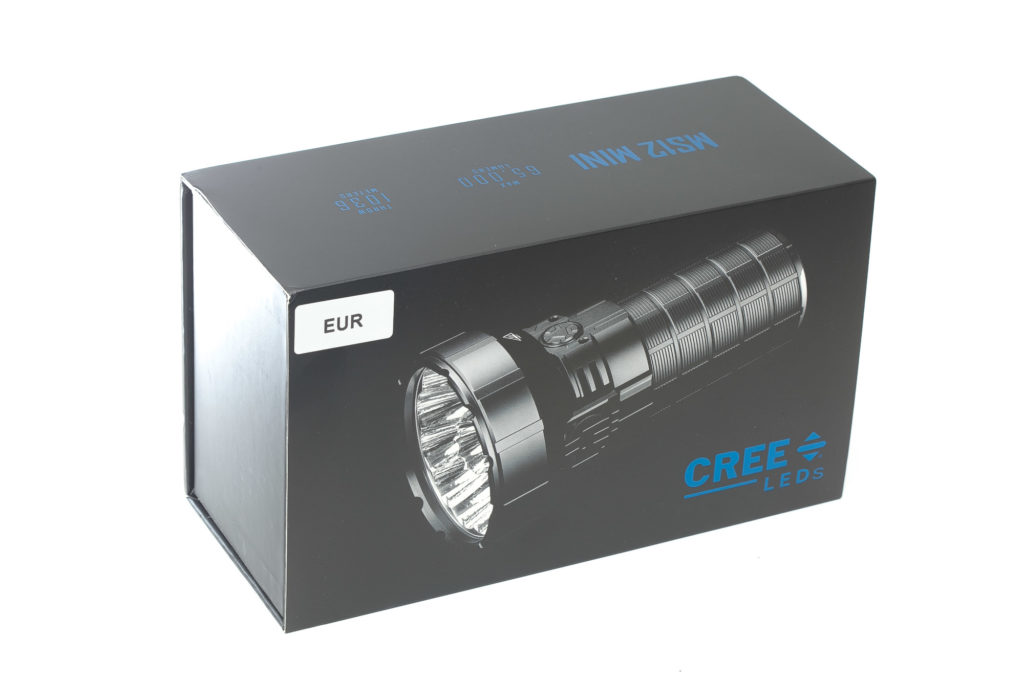
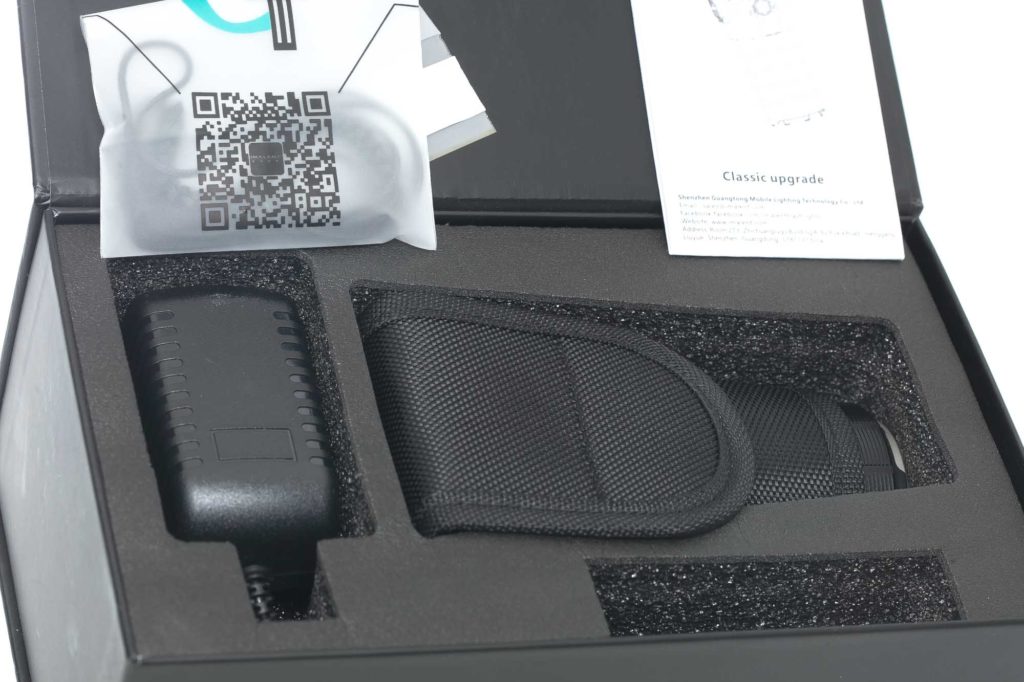
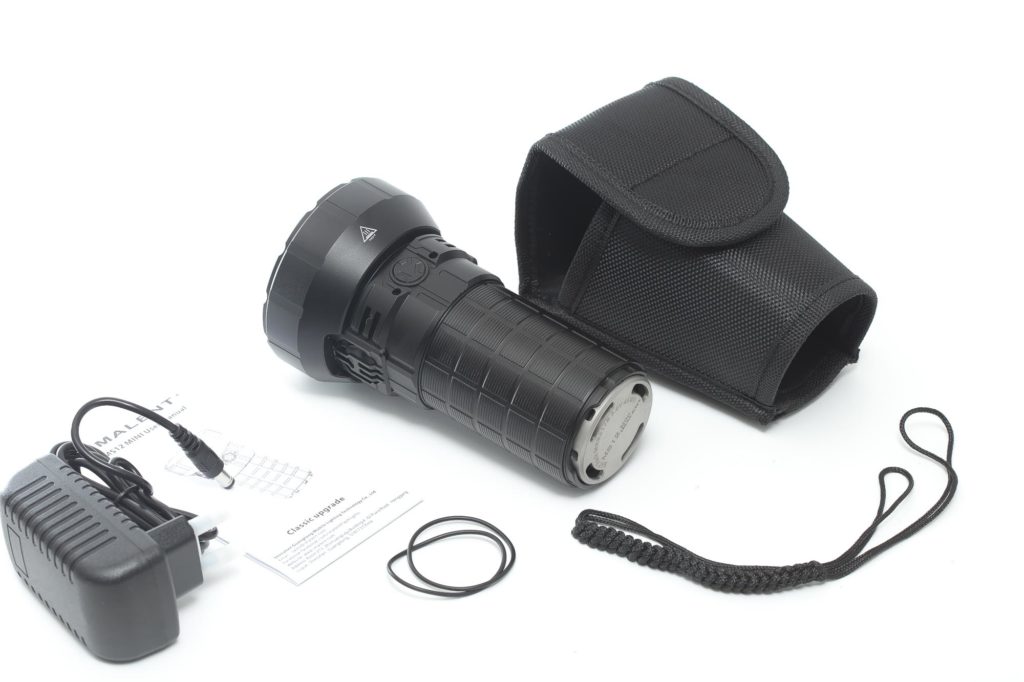
Flashlight in use
After reviewing many Imalent flashlights, including the MS18, MS12, R90TS, etc.. I can see why Imalent called it the MS12 Mini .. But that doesn’t mean it’s really tiny. It just means that it’s based on the Imalent MS12 (with 12 LEDs) but then in a much smaller form factor.
Because this battery pack contains 4*21700 batteries, the diameter of the battery tube is noticeably larger than the ones with 4*18650 batteries. This makes it a bit harder to for people with small hands.
Imalent also included a lanyard that can be attached to the plate covering the charge port. I’m not convinced that this is a good way to carry it, because the plate can be unscrewed from the flashlight. So, if you’re not paying attention, the plate could unscrew, and drop the light if you just carried it with the lanyard. There is no lanyard attachment point anywhere else on the flashlight.
Another thing I miss is a tripod mount. Some of the bigger lights could really use one. Or maybe Imalent could produce a handle for these lights with a tripod mount. Just thinking aloud.
Also, if you have really large pockets, this light could possibly fit!
You could take it on your next camping trip, or use it as backup lighting at your local soccer field. lol.
There’s 1 thing that I don’t like so much about the Imalent MS series, and that’s the switch. It’s really hard to find in the dark because it’s flat and black. I’d like to have a larger switch, that’s either sticking out or have something to make it easy to find… Something along the lines of the switch used on the MicroFire Excalibur H20. Not exactly like that, but at least something physical to make it easier to find.
The battery tube looks a bit like MS08, but with deeper lines, and therefore looks much better in my opinion. It also gives more grip, so that’s a good thing.
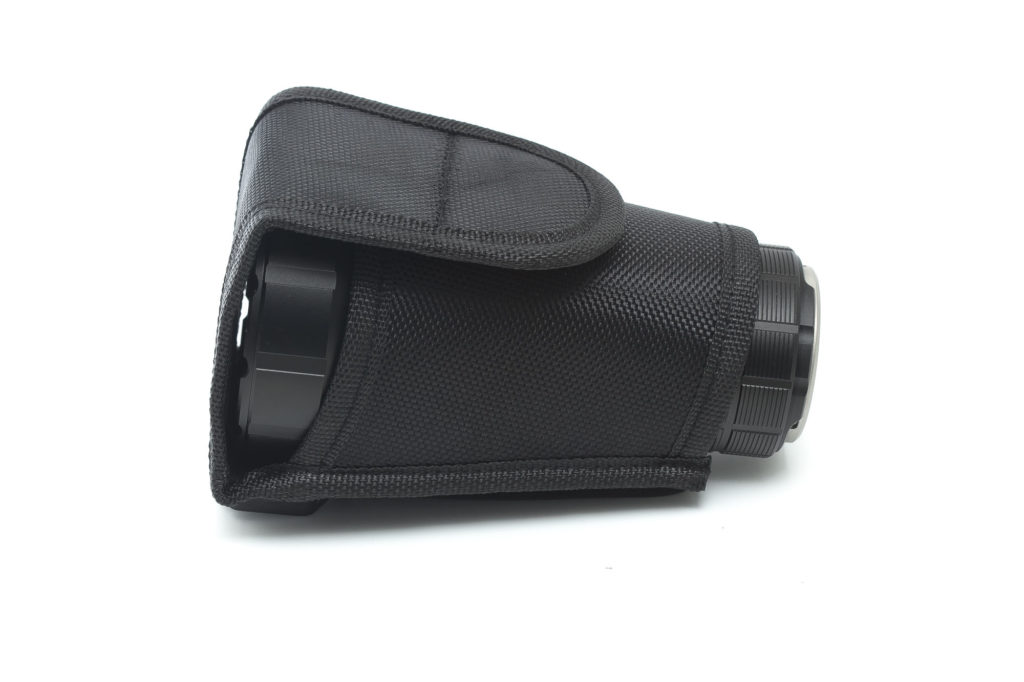
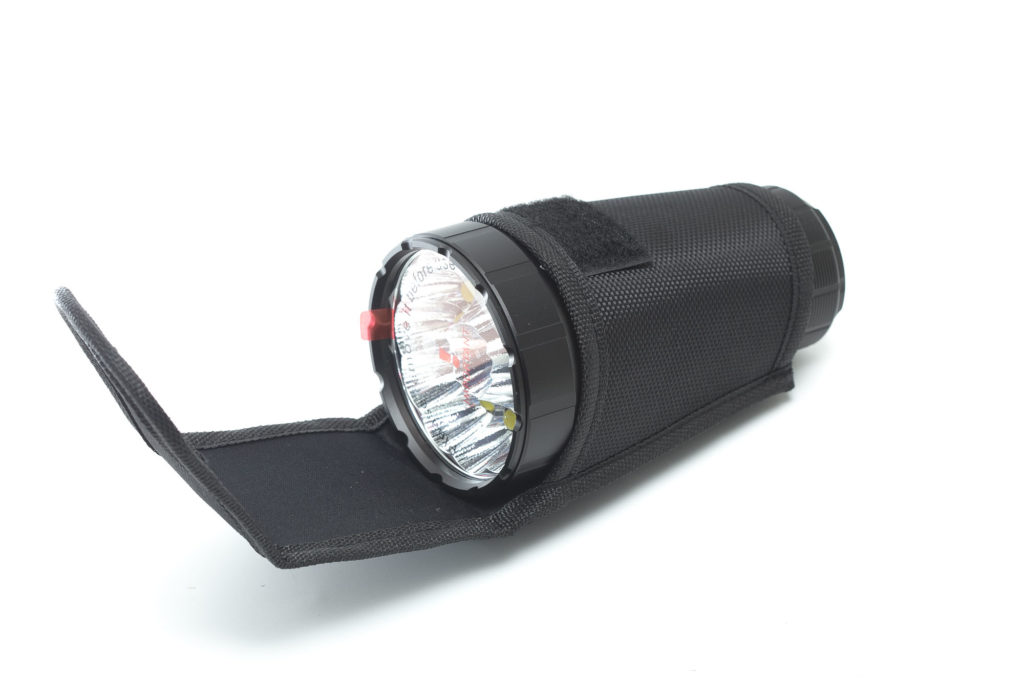
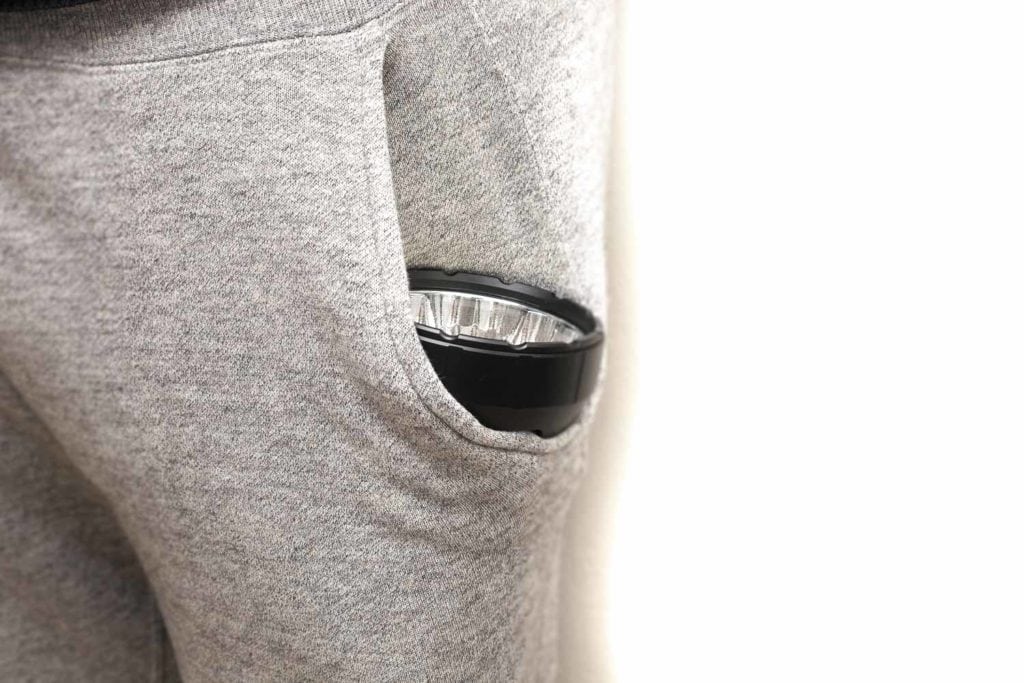
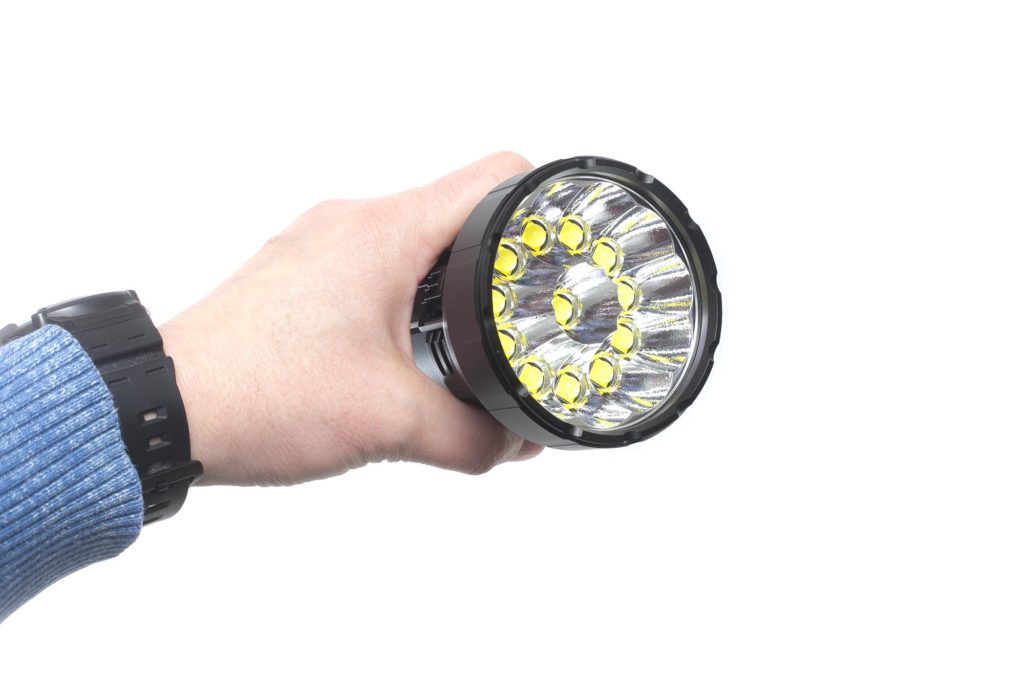
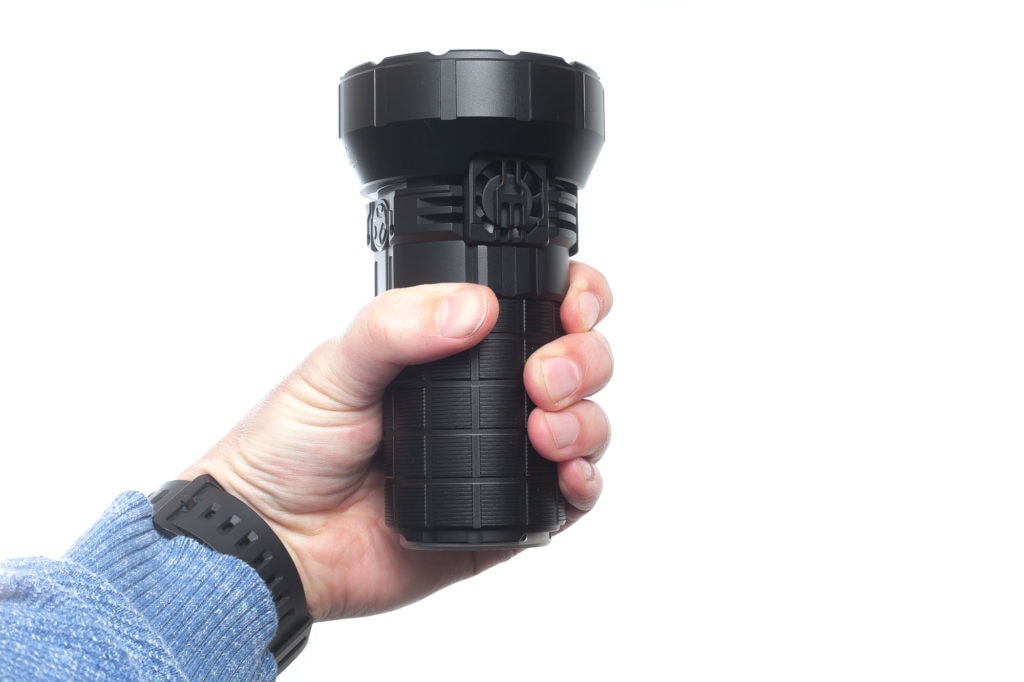
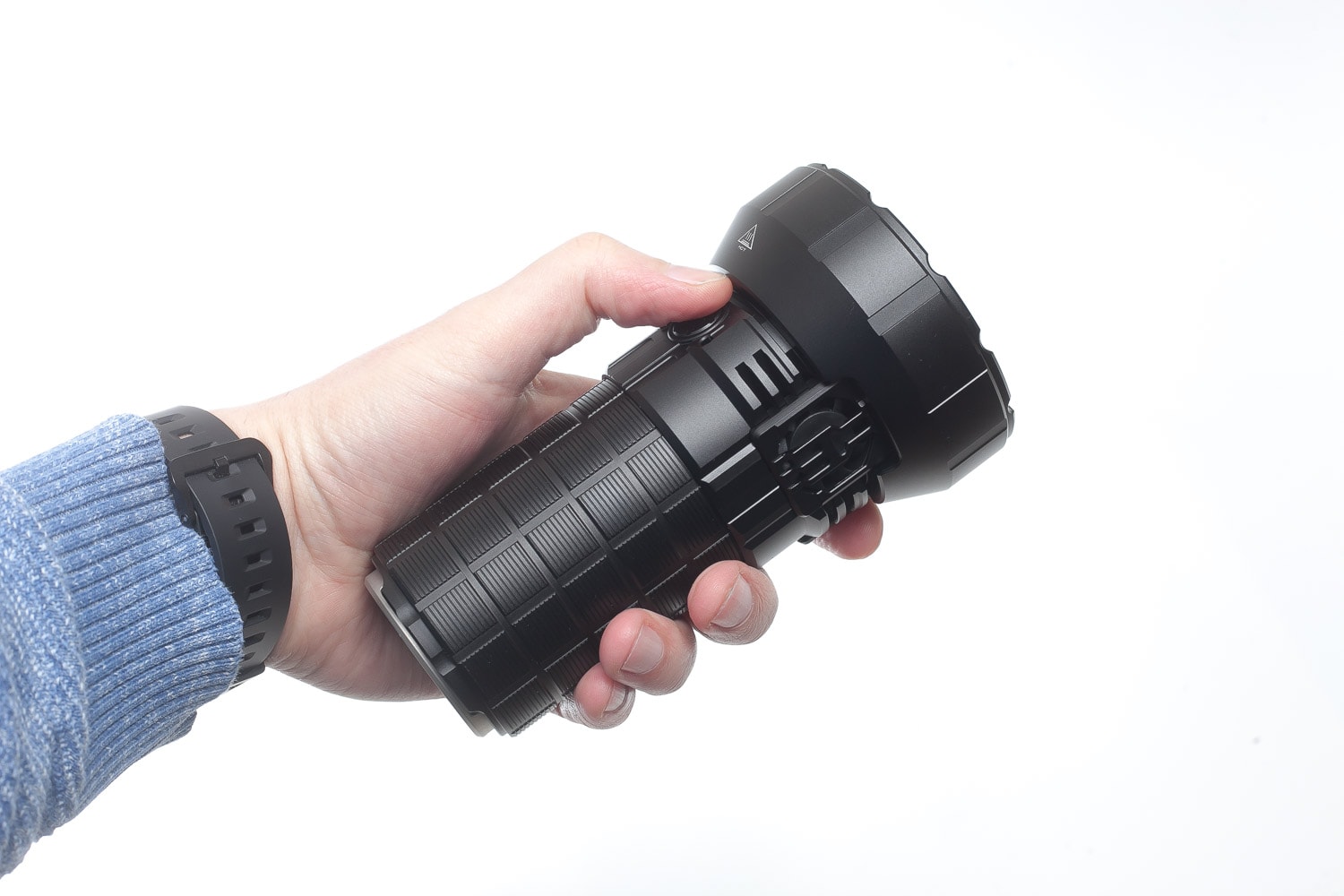
Build Quality, and Warranty
The MS12 Mini is black, and I’m pretty sure it won’t be available in any other color. The anodization is referred to as Wear-resistant Type III hard-anodized and has a nice matte finish that looks much better than any shiny black coating seen on some other flashlights.
There’s only 2 parts you can separate: the body and head. The threads are anodized, so you can easily break any electric connection by unscrewing the body by just 1/10th of a turn. The threads are thick, and covered in plenty of lubrication. Then there’s a single o-ring below the threads to keep water out. And it seems to have 1 unused slot to add another o-ring for more waterproofness.
I’m not sure how much that would help though, because the things I worry about most, are the fans. There are 3 cooling fans to keep the temperature down, but I’m not sure how waterproof they are. The water resistance rating (IPX rating) for the MS12 Mini is just IP56, so I wouldn’t recommend using it in wet environments, or during rainstorms.
The fans make quite a bit of noise and reduce speeds when you shake the light. That probably means you shouldn’t be waving with the light too often, or use it on things that move/shake a lot.
Unlike the Imalent MS08 and RS50, the MS12 MINI doesn’t have a plastic shell with the fans built-in. They still don’t seem to be controlled by temperature, but turn on at 5,000 lumens or more (which means from Middle1 mode onward).
To test if they are now temperature controlled, I turned on Turbo mode till it reaches 70 degrees (I used a Uni-T thermal camera for checking) and then switched back to Low mode.. the fans didn’t turn on… So they aren’t temperature controlled, but mode-controlled. While the MS18 would still get immensely hot at 10,000 lumens (and not switch on the fans), the MS12 Mini turns on the fans at 5,000 lumens.
At the end of the runtime tests, the fans would turn off, and then the light soon afterward.
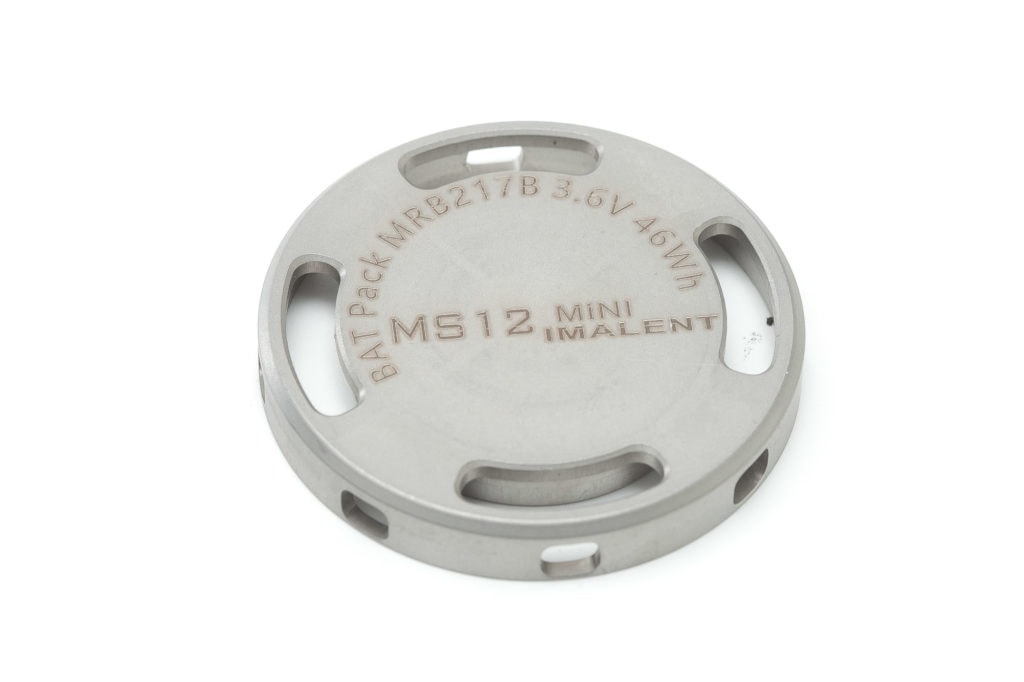
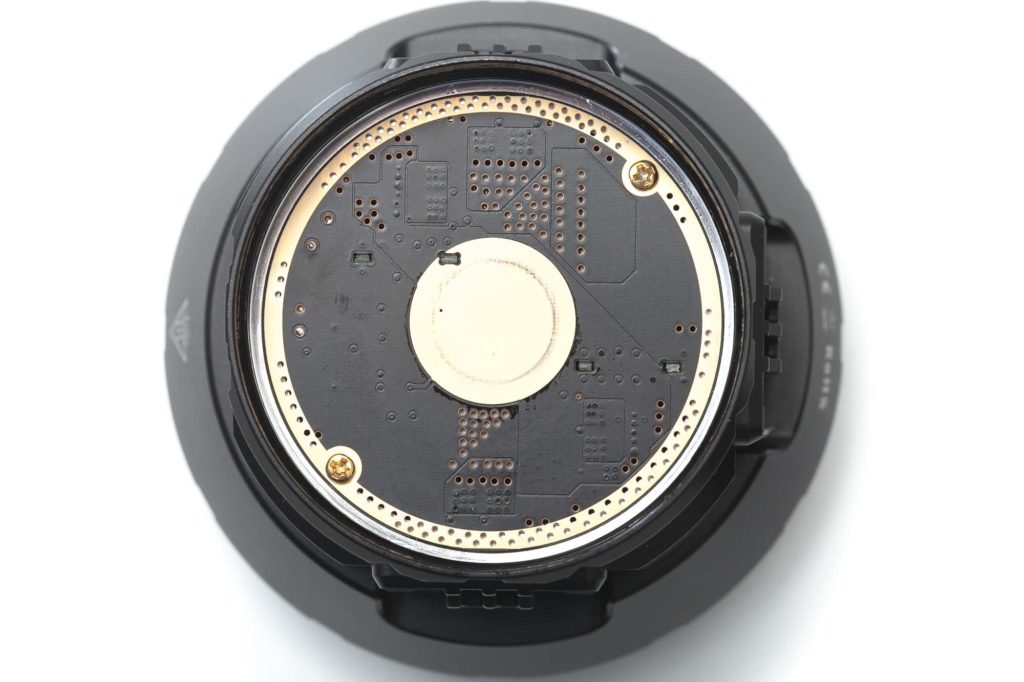
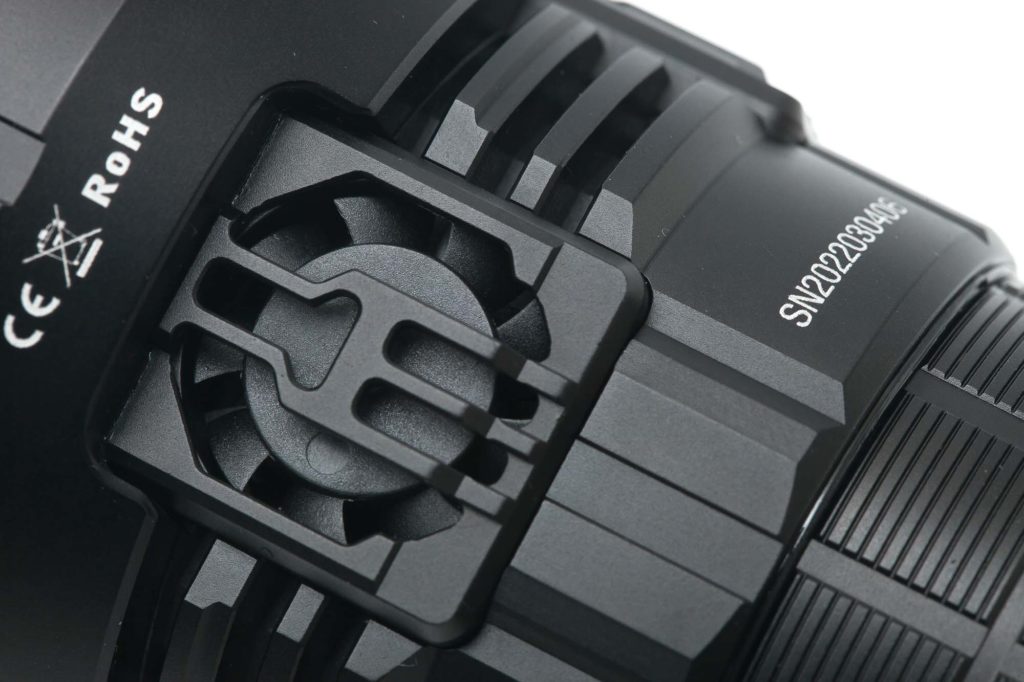
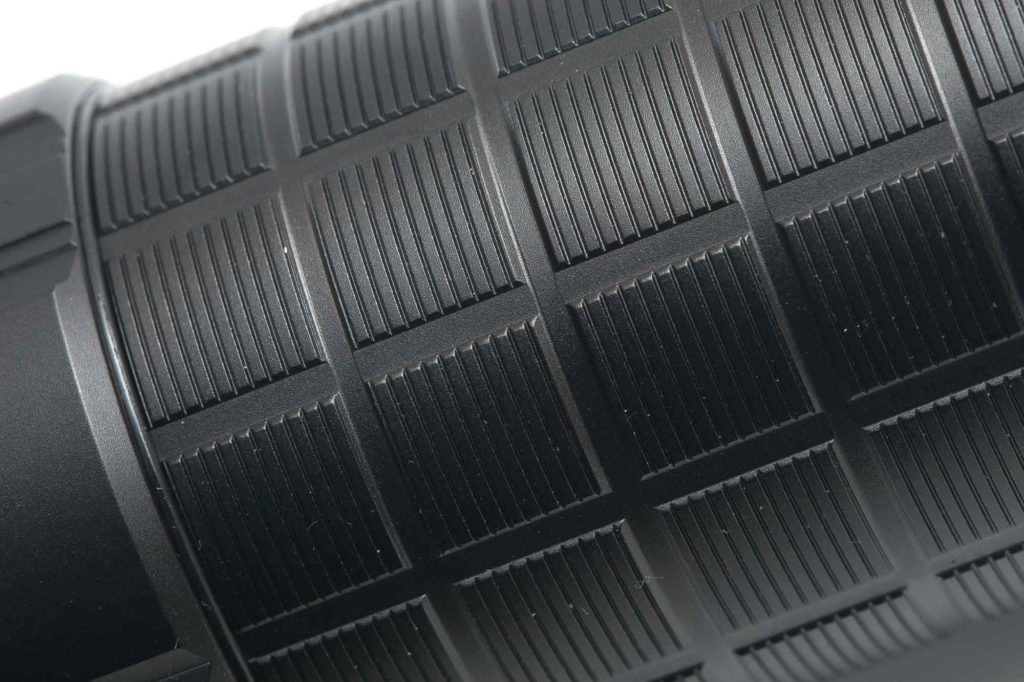
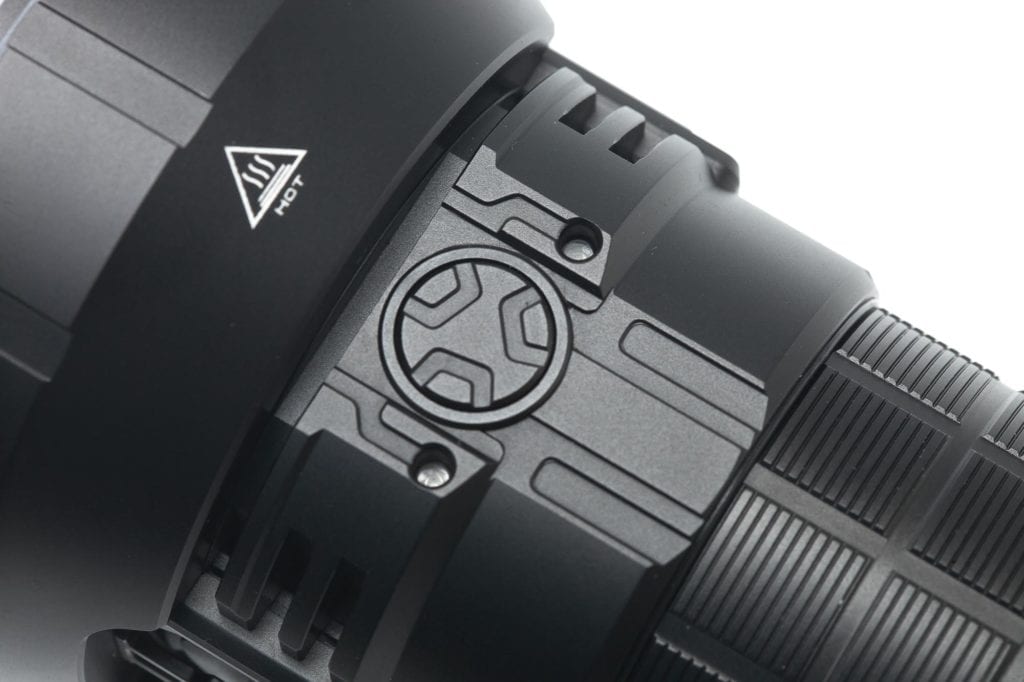
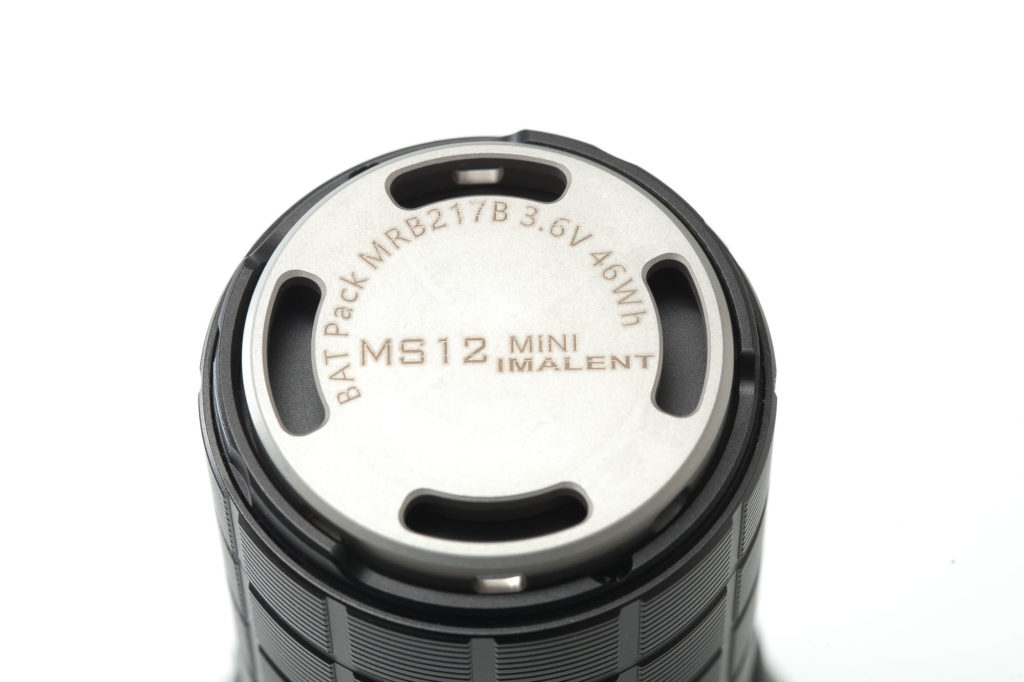
LED, Lens, Bezel, Beam, and Reflector
There’s a few physical differences between the MS12 and MS12 Mini, but the number of LEDs stayed the same. The old XHP70’s are now replaced with the newer XHP70.2. Soon, this light will also be available with the newest XHP70.3 for even more beam distance, but at the cost of output.
The 12 LEDs sit in reflectors with a light orange peel (LOP) finish that makes the beam a bit smoother than smooth reflectors. Specifications say the reflector is made of aluminum but I doubt that.
The bezel is not removable by hand and looks like normal aluminum. It does have a few grooves, so you can still see light when it’s placed with the head down on a flat surface. The lens has an anti-reflective coating.
I used the Opple Light Master 3, to measure beam color temperature, and CRI, in Low mode, and 1 of the Medium modes. I held the flashlight at a distance of about 80-90 centimeters and measured the center of the beam.
For low mode, I got the following measurements. Keep in mind that the Opple Light Master is not a laboratory-grade piece of equipment, and is only a guide.
- CCT: 5620K
- Ra (CRI): 67.7
- DUV: 0.0049
And for a Medium mode:
CCT: 5772K
Ra (CRI): 68.7
DUV: 0.0031
5700K means that the beam is on the cool side.
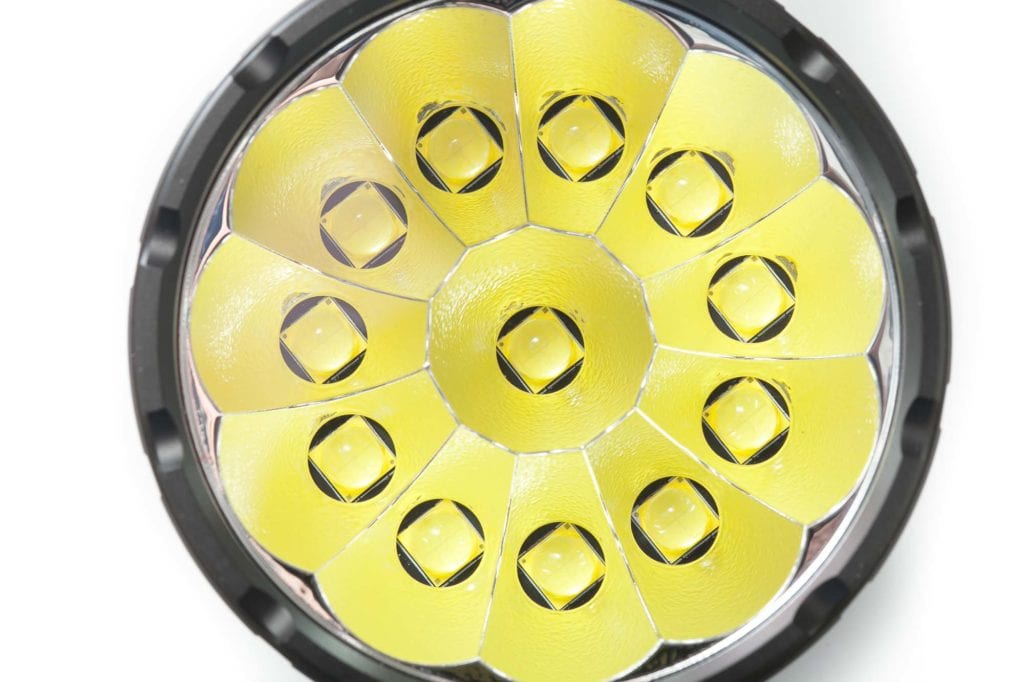
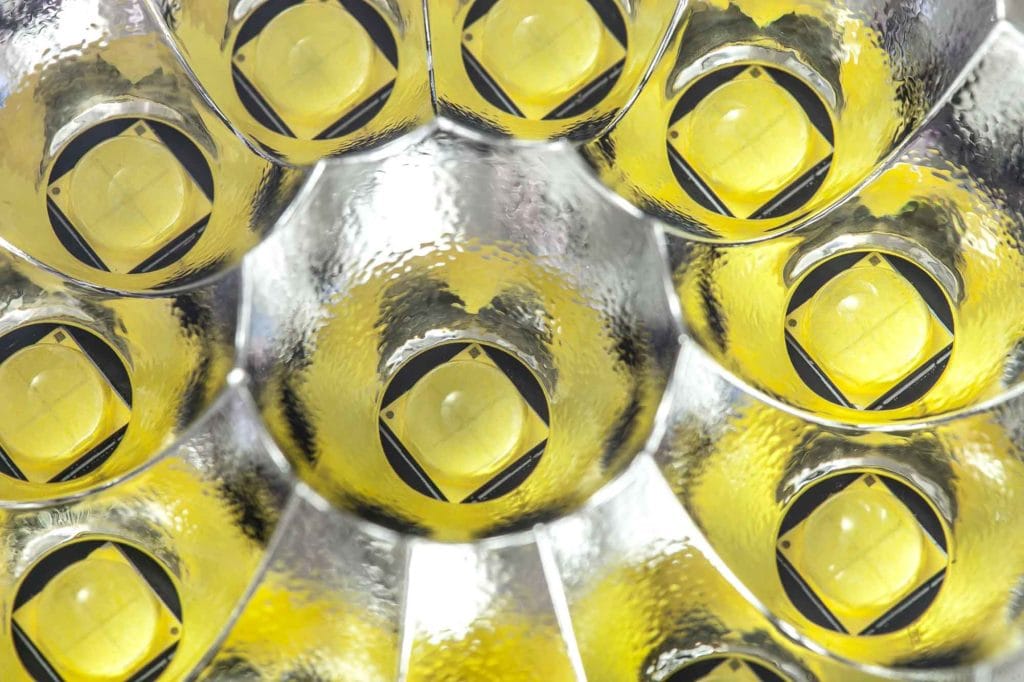
Dimensions and size comparison
- Length: 146.3 mm / 5.76 ”
- Head diameter: 84.8 mm / 3.34 ”
- Body diameter: 56.2 mm / 2.21 ”
Weight:
- With battery: 798.3 g / 28.16 oz
Flashlight comparison
Size compared to other high output flashlights
Group 1, from left to right: Imalent MS12, Imalent MS12 Mini
Group 2: Imalent R90TS, Imalent MS18, Imalent MS12, Imalent MS12 Mini
Group 3: 3 siblings: Imalent MS12 Mini, Imalent MS08, Imalent RS50
Last image: you figure it out :–)
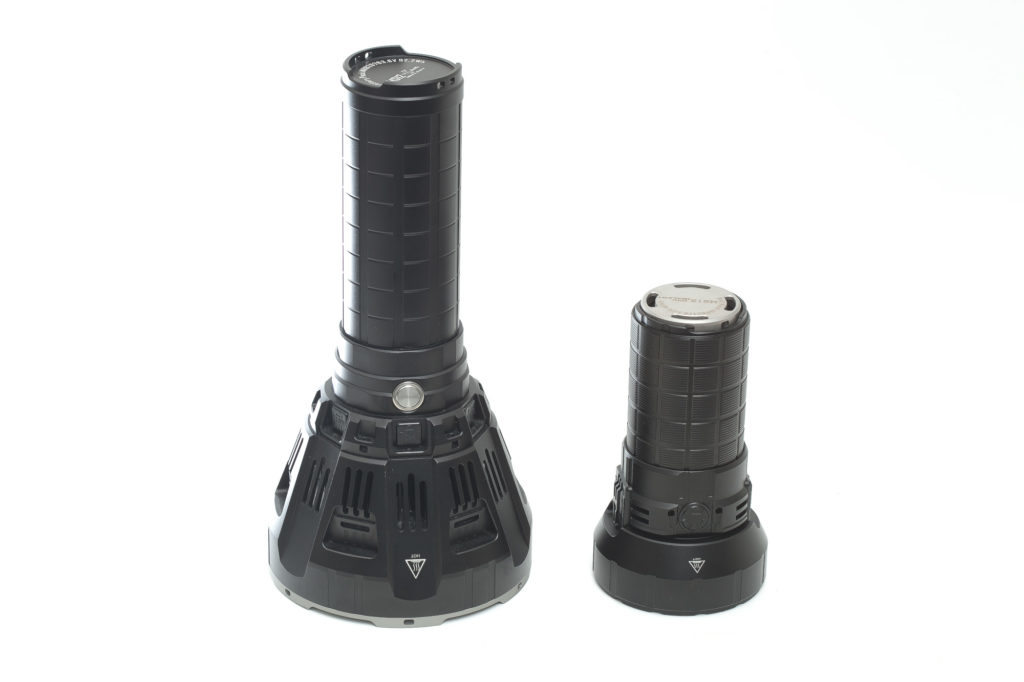
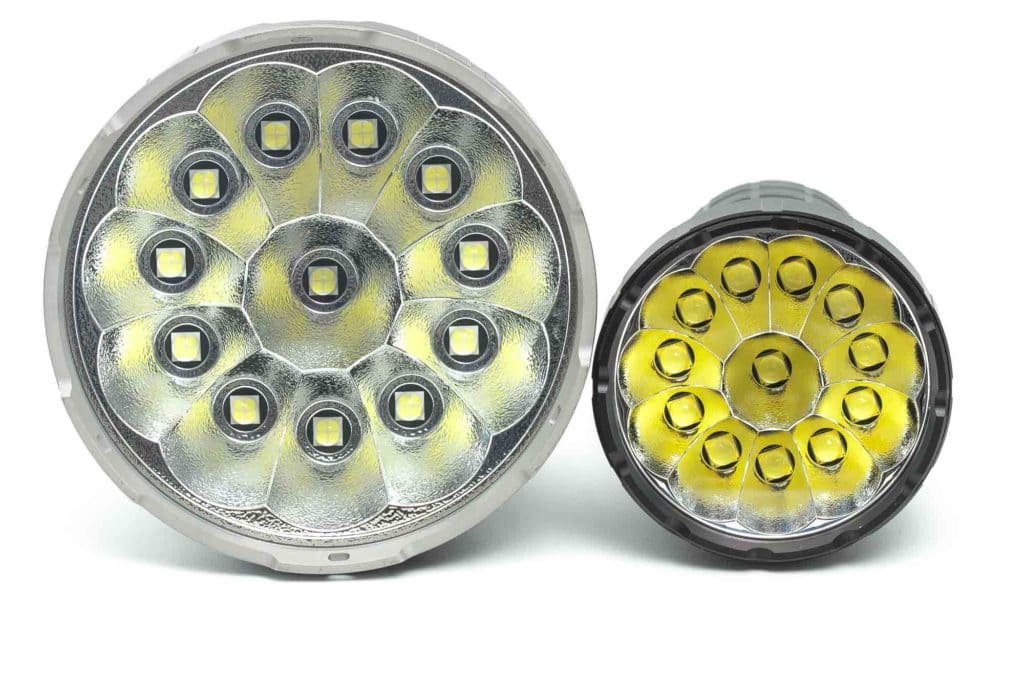
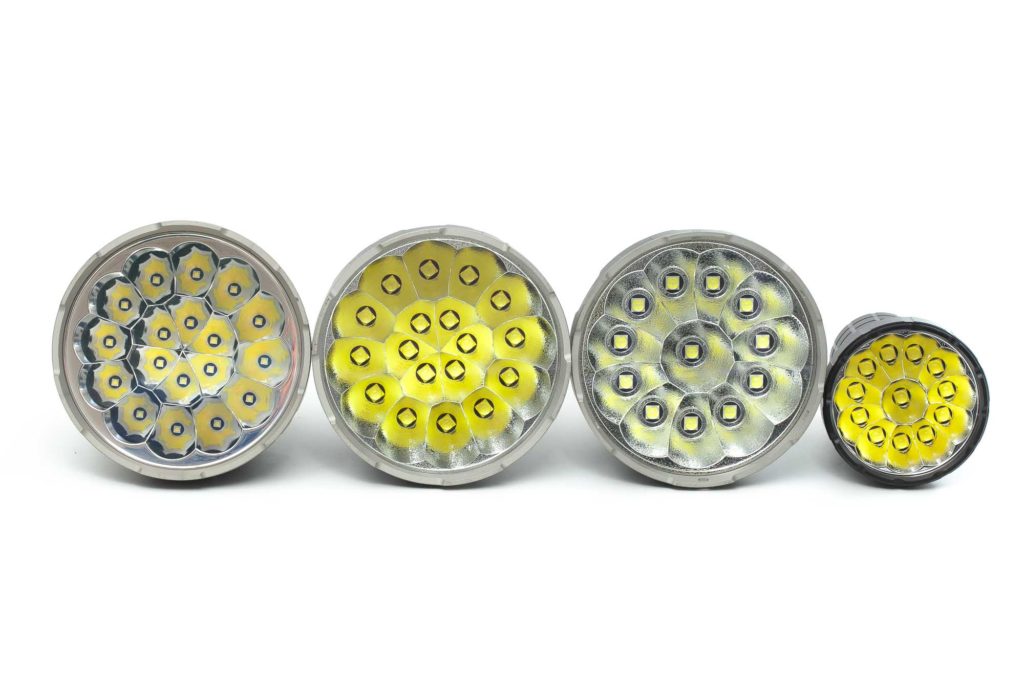
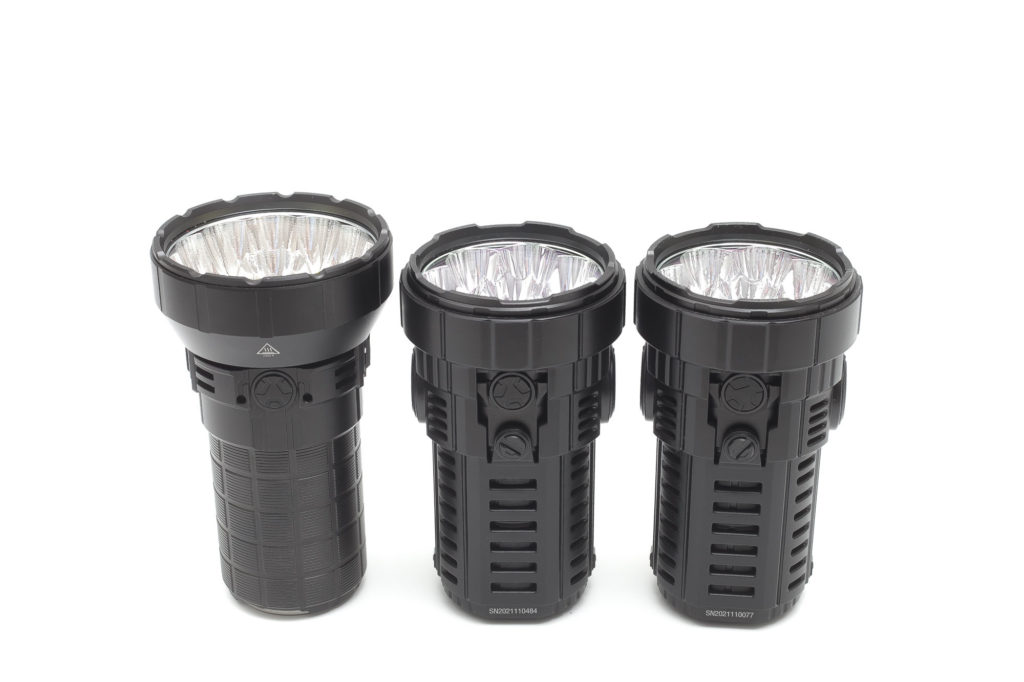
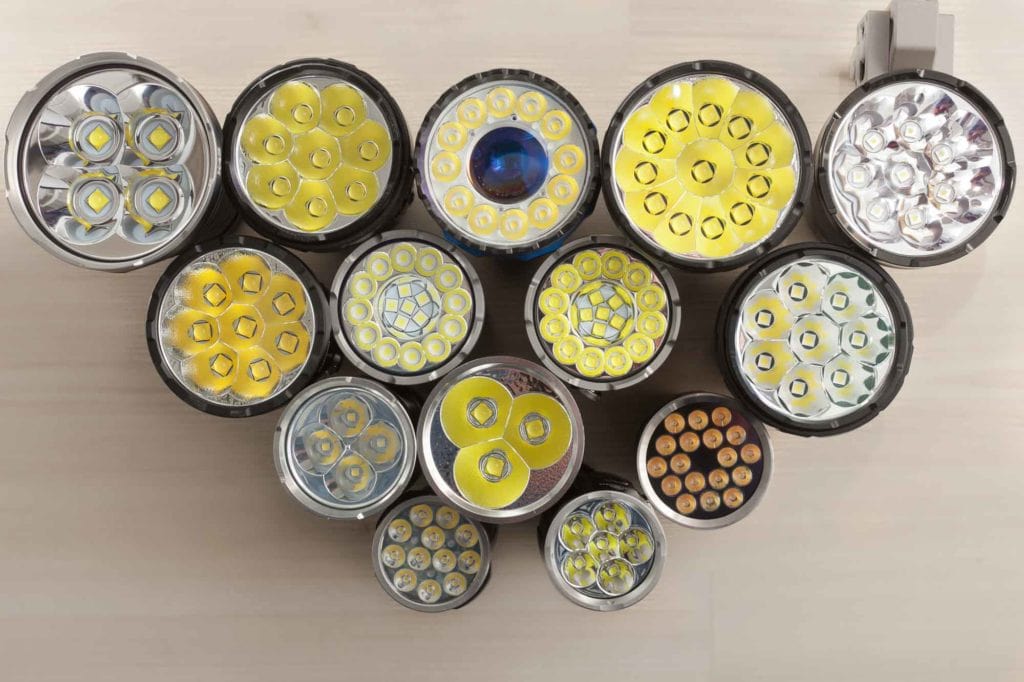
Driver & User Interface:
Available modes:
- Low, Middle Low, Middle 1, Middle 2, High, Turbo
- Strobe
From OFF:
- Single-click: to last used mode ( mode memory)
- Double click: Turbo (and another double click for strobe)
- Triple-click: Low mode
- 4+ clicks: Lockout
- Press and hold: turn on cooling fans (repeat to turn them off)
From ON:
- Single-click: off
- Double click: Turbo
- Triple-click: Low mode
- Press and hold: Cycle through the menu from Low to High
Shortcuts:
- To Turbo: double click from Off or On
- To Low: 3 clicks from Off or On
- To Strobe: 2 times double click (it will first enter Turbo, before entering Strobe)
Mode memory:
- Yes (single click from off returns ot last used mode)
Blinky modes menu:
- Strobe: double click from Turbo (so if you are in any mode, double click for Turbo, and do another double-click for Strobe
Low battery warning:
- The red indicator lights on the side will flash, and the output will drop before it turns off.
Lock-out mode:
- 4+ clicks from off. The green indicator lights next to the switch blink 3 times to indicate the lockout mode is activated. Repeat 4 clicks to deactivate again. You can also do 5 clicks or 10 clicks.. works the same.
PWM:
- Not visible
Batteries & Charging
Imalent chose to use a built-in battery pack rather than separate cells. This was the same on the MS12, and MS18. A battery pack has benefits and several drawbacks at the same time. Here’s a short list:
- Need to stop using the light when batteries are empty (can’t replace batteries and continue)
- Can’t replace batteries easily when they become really bad
- Can’t use a normal battery charger to charge batteries
- Have a set of batteries with the same use (so can’t accidentally mix discharged and charged batteries)
I’m not 100% sure if it’s a feature, but I could continue using the light when the power was plugged in.
The power adapter for charging has an output of 19V and 2Amps, and I measured an average of 18.8V and 1.8Amps (32watt). Charging takes about 2 hours and 10 minutes. During charging, there are red lights, which turn green when charging has finished.
2 tiny indicator LEDs next to the switch tell you when the battery goes empty.

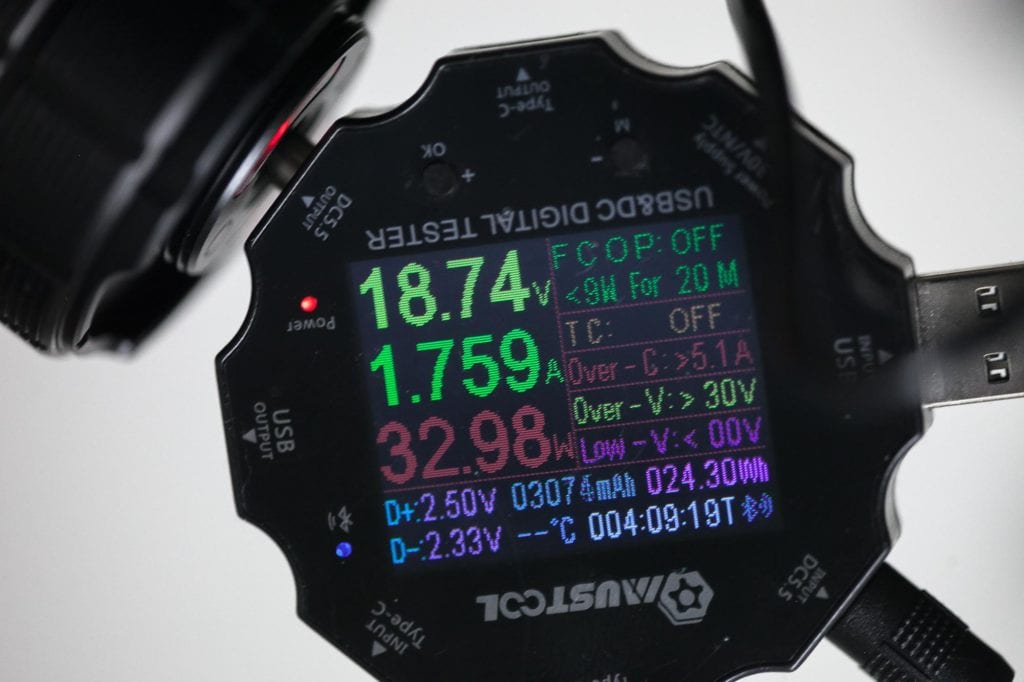
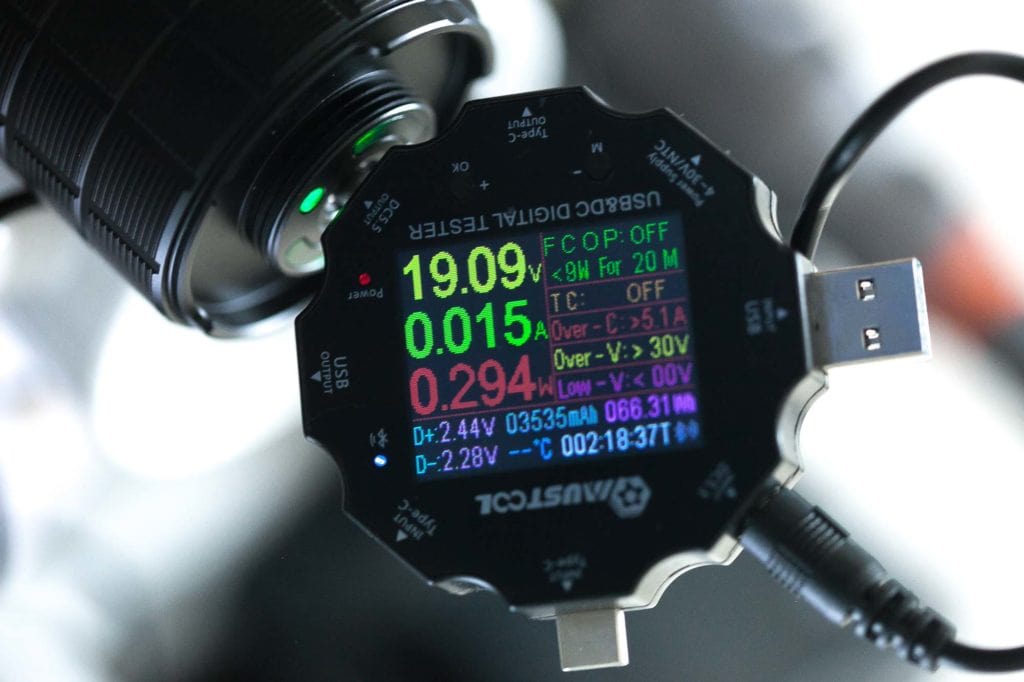
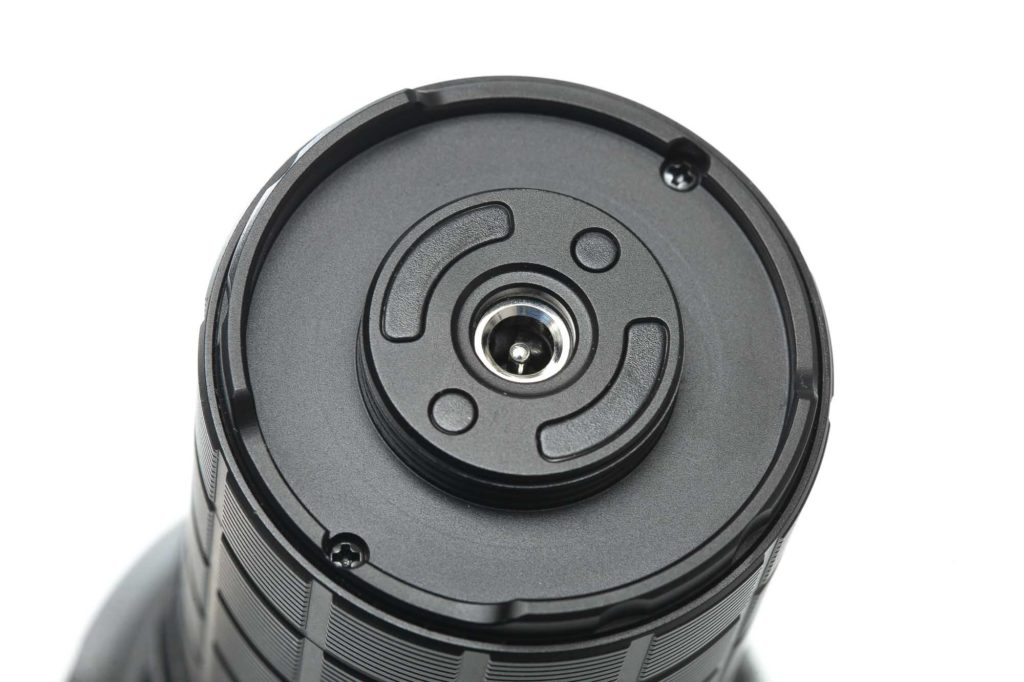
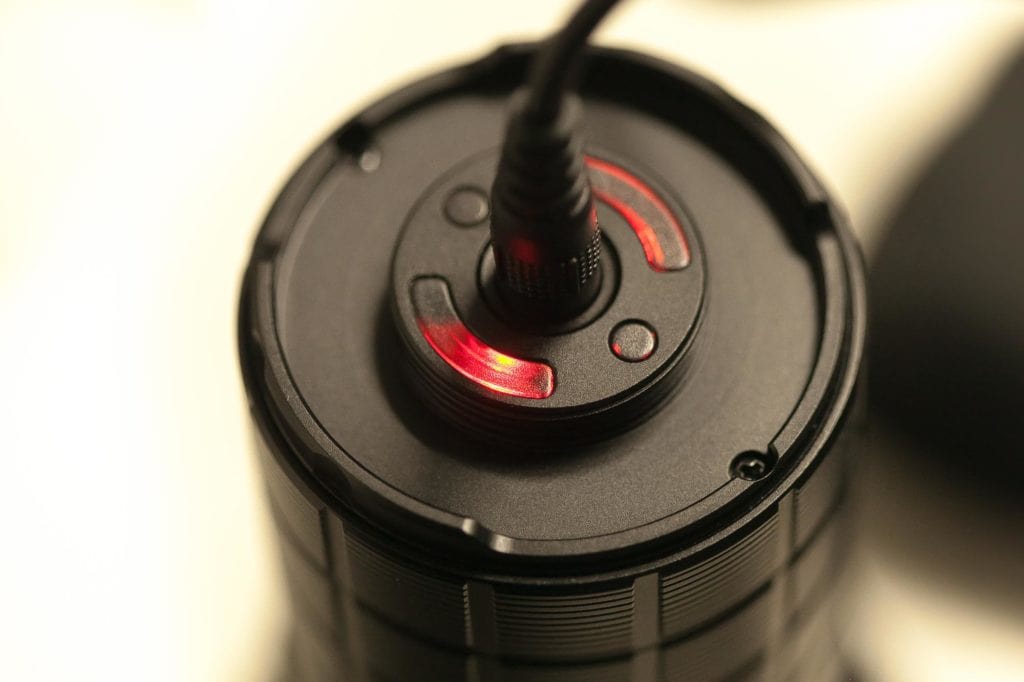
Performance test
This is the gear I used for testing:
| Gear | Purpose | Link to buy |
|---|---|---|
| Hagner E4-X | Measuring beam intensity (throw) | Inquire at Hagner.se |
| Extech SDL400 | Lumens and logging runtimes | Amazon.com, Amazon.co.uk, |
| Leica Disto D2 | Distance for throw measurements | Amazon.com, Amazon.co.uk, |
| Uni-T UTi260B | Thermal camera | Amazon.com, |
Lumen measurements:
All output numbers are relative to my homemade Integrating Sphere. It is set up with an Extech SDL400 Lux Meter for measurements including a Kenko PRO1D ND-16 filter. The base measurement is done with a Convoy S2+ that has been tested at 255 lumens.
For Amp readings, I use a Fluke 77III DMM. For higher amps I now use a Fluke 325 True RMS clamp meter. For microamps, I use a cheap DMM with an easy-to-use micro amp setting.
All of my readings were taken with a fully charged battery.
| Mode | Specs | start | 30 sec | 10 min |
|---|---|---|---|---|
| Low | 1,500 | 2,048 lm | 1,955 lm | 1,850 lm |
| Mid Low | 3,000 | 3,222 lm | 3,168 lm | 3,047 lm |
| Mid 1 | 5,000 | 5,030 lm | 4,961 lm | 4,829 lm |
| Mid 2 | 13,000 | 11,274 lm | 11,104 lm | 10,566 lm |
| High | 25,000 | 26,659 lm | 25,886 lm | 10,487 lm |
| Turbo | 65,000 lm | 68,773 lm | 46,750 lm | 10,454 lm |
Tubo was able to reach over 65,000 lumens, but only for a very brief moment, it dropped to 46,750 lumens in 30 seconds.
Parasitic drain:
- Unable to measure.
Runtime:
The runtime test was done with the 50cm integrating sphere, including the Kenko Pro1D ND-16 filter and Extech SDL400 data logging Lux Meter.
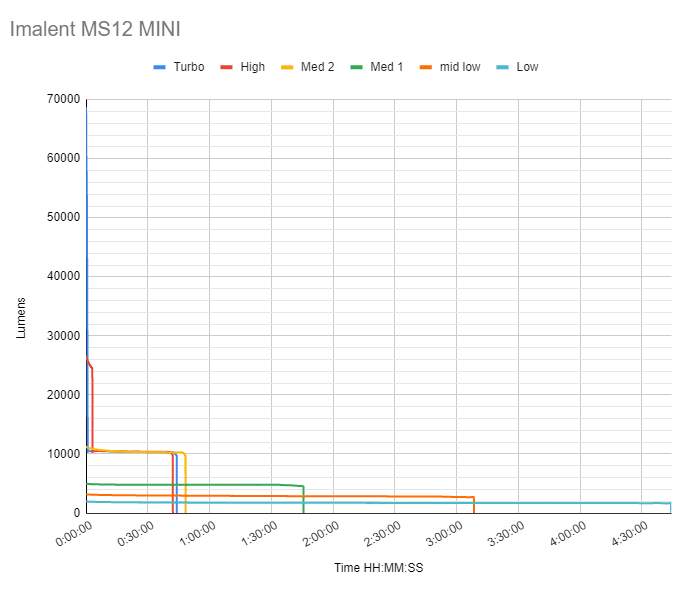
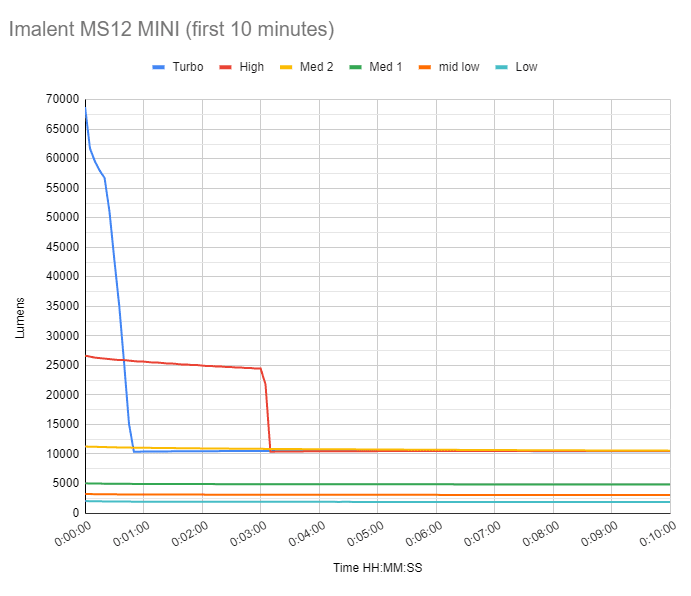
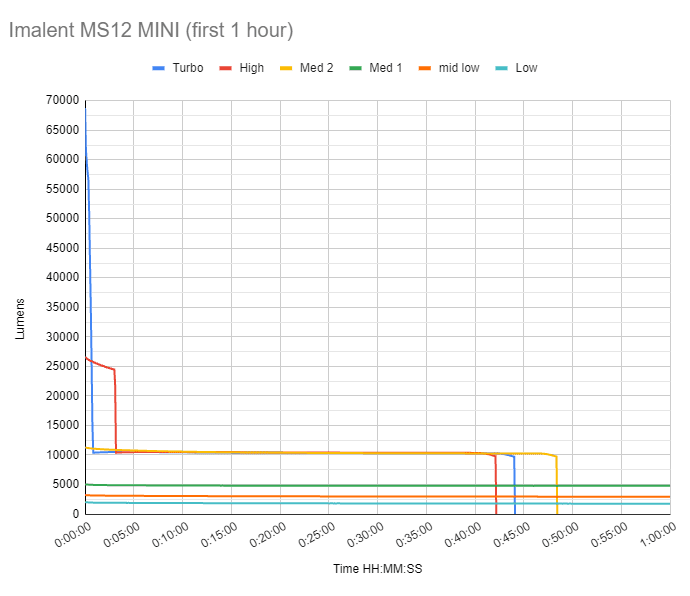
Turbo mode started over 65000 lumens and dropped to just above 10,000 lumens in 50 seconds. At 0h44min the light shuts off, soon.
High mode starts at over 26,000 lumens and slowly decreases to 24,000 lumens in exactly 3 minutes, and then drops to about 10,000 lumens as well. Total runtime: 0h42min
Med2 is quite stable at 10,000+ lumens and sustains this output till it turns off at 0h48min
Med1 runs at 5,000 lumens for 1h45min before it turns off.
Med Low runs at a little over 3,000 lumens for 3h08min.
Low runs at 1700-1800 lumens straight till it turns off at 4h44min
During the runtime test in Low, and Middle Low, the flashlight stayed below 50 degrees celsius, and didn’t activate the cooling fans.
The thing I would like Imalent to upgrade is the fans being controlled by temperature, and not just by mode. Fortunately, you can still turn the fans on manually by a long press from Off. That’s great, because it really helps to cool the light down. But temperature-controlled fans would have been even better… just in case.
Throw Measurement
Measurements were taken both indoors and outdoors with a Hagner E4-X Lux Meter. Outdoors I tested it at 20 meters, and indoors at 5 meters. I measured indoors at turn on (which we shouldn’t really look at) and after 30 seconds both indoors and outdoors.
| Mode | Specs | candela | meters | Yards |
|---|---|---|---|---|
| Turbo (20 meters) | 268,600 cd | 116,000 cd | 681 | 745 |
| Turbo (5 meters turn on) | 268,600 cd | 152,750 cd | 782 | 855 |
| Turbo (5 meters 30 seconds) | 268,600 cd | 120,000 cd | 693 | 758 |
Wow, that didn’t do well.. roughly 120,000 instead of 268,000 is not even 50%.
Performance comparison other brands and models
High power flashlight comparison
Here is the list with most of the high-power flashlights we reviewed in this category (Category: high-power soupcan sized flashlights).
| Flashlight | Max. Output | after 30sec |
|---|---|---|
| Acebeam X50 | 35,507 | 30,383 |
| Acebeam X75 | 64,295 | 73,716 |
| Acebeam X80-GT2 | 31,890 | 27,143 |
| Astrolux EC06 | 18,111 | 8,352 |
| Fenix LR50R | 11,698 | 10,849 |
| Imalent MR90 | 52,326 | 32,128 |
| Imalent MS08 | 25,745 | 19,615 |
| Imalent MS12 Mini | 68,773 | 46,750 |
| Imalent MS12 Mini C | 71,967 | 55,873 |
| Imalent RS50 | 20,302 | 16,939 |
| Imalent SR16 | 53,657 | 43,115 |
| Lumintop GT3 | 16,267 | 15,168 |
| Manker MK38 (SFT) | 16,013 | 13,129 |
| Olight Marauder 2 | 14,251 | 13,964 |
| Thrunite TN50 | 18,200 | 17,360 |
(Interactive line graphs below)
Hover your mouse over the lines in the graph to see more details, or select a flashlight in the graph.
Using a mobile phone? Hold your phone horizontally!
Another comparison, focusing on the first 10 minutes after activation
And here’s another comparison, but zoomed in. The first 60 minutes after activation.
The Imalent MS12 performs extremely well.. even compared to the brightest flashlights in the world.. see below
Beamshots
For the following beamshots, I used a Canon EOS 5D Mk2 with a 50mm lens. Manual settings: ISO1600, 1/4sec , f4, 5000K
The shed is about 65 meters / 71 yards away. The second set of pictures: 200 meters to the reflective fence.
Comparison with other high power flashlights.
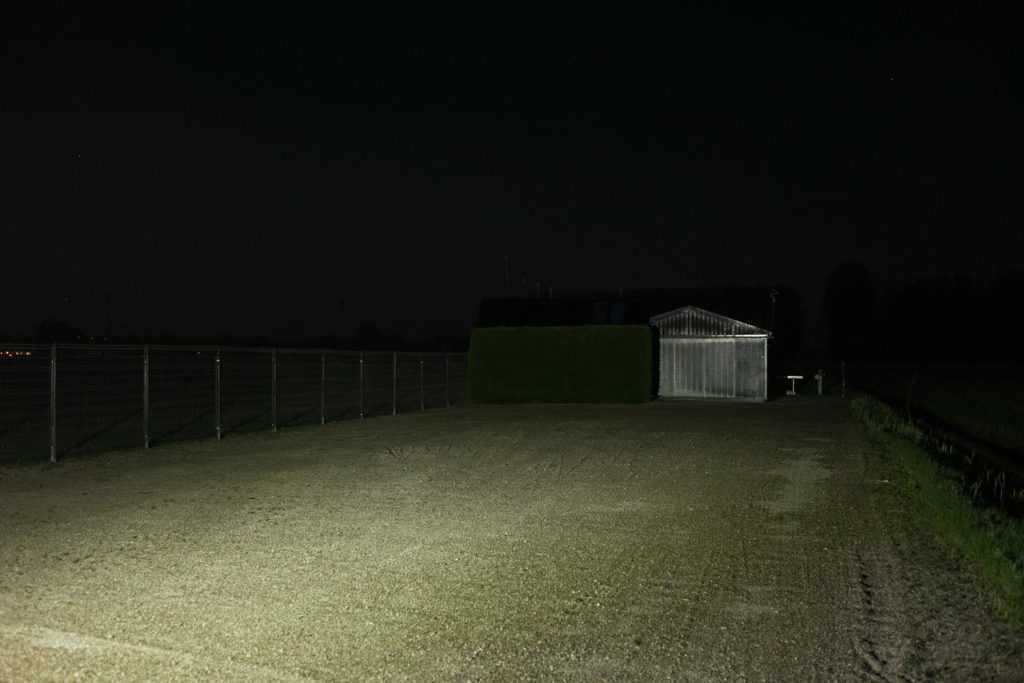
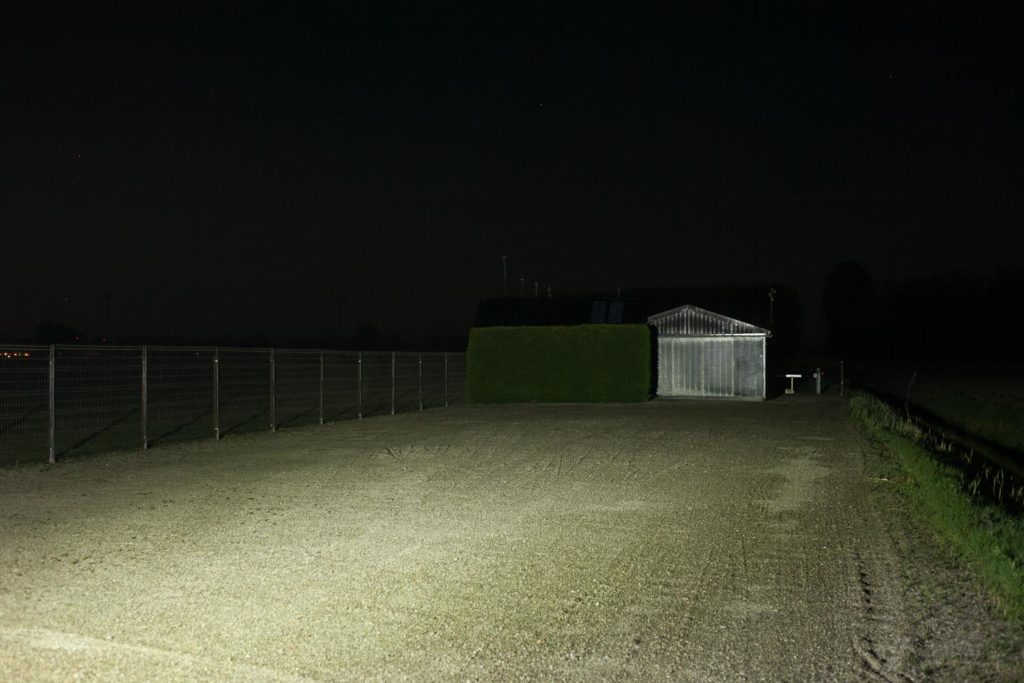
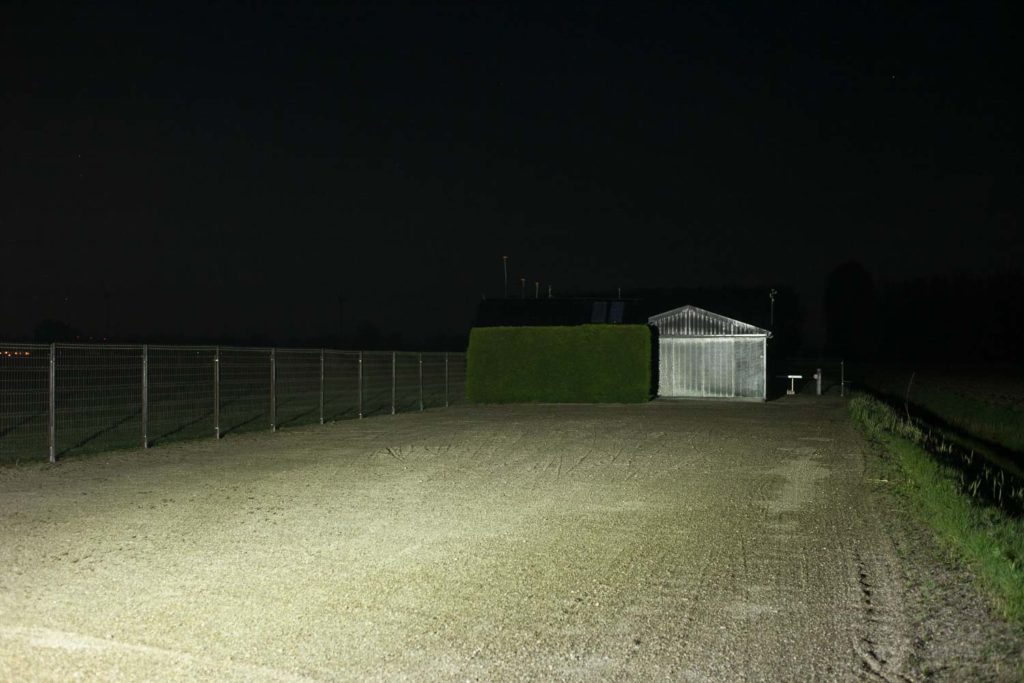
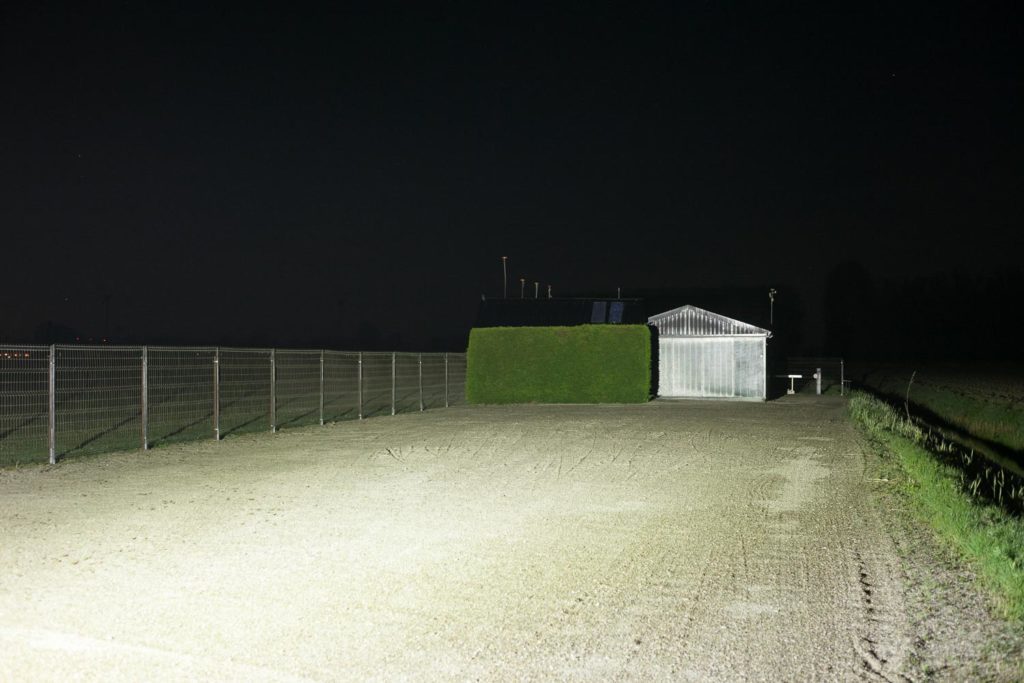
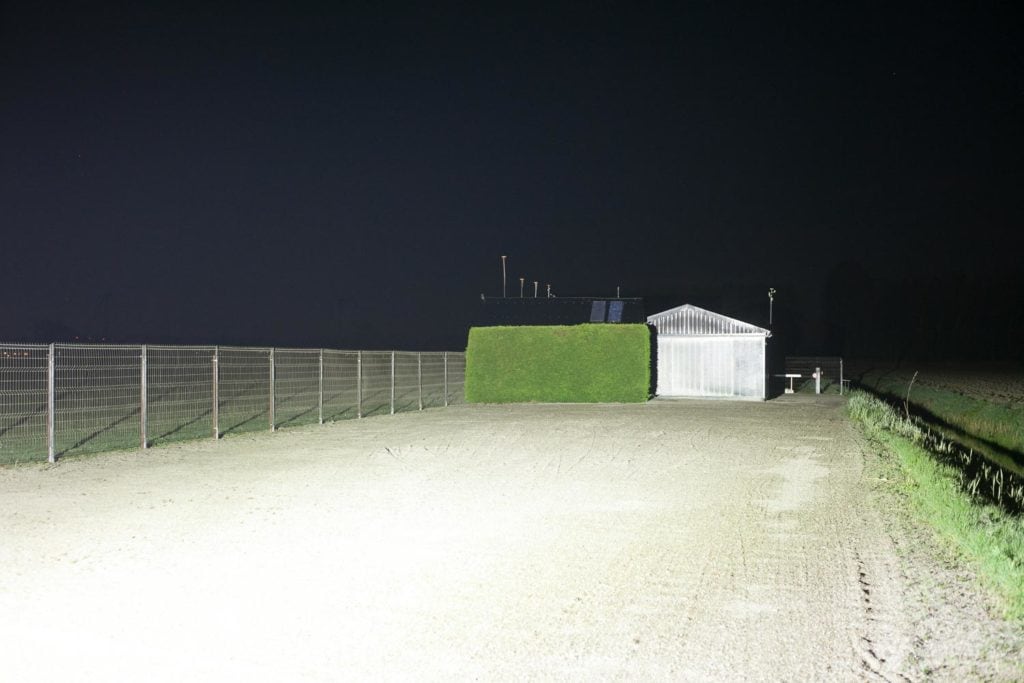
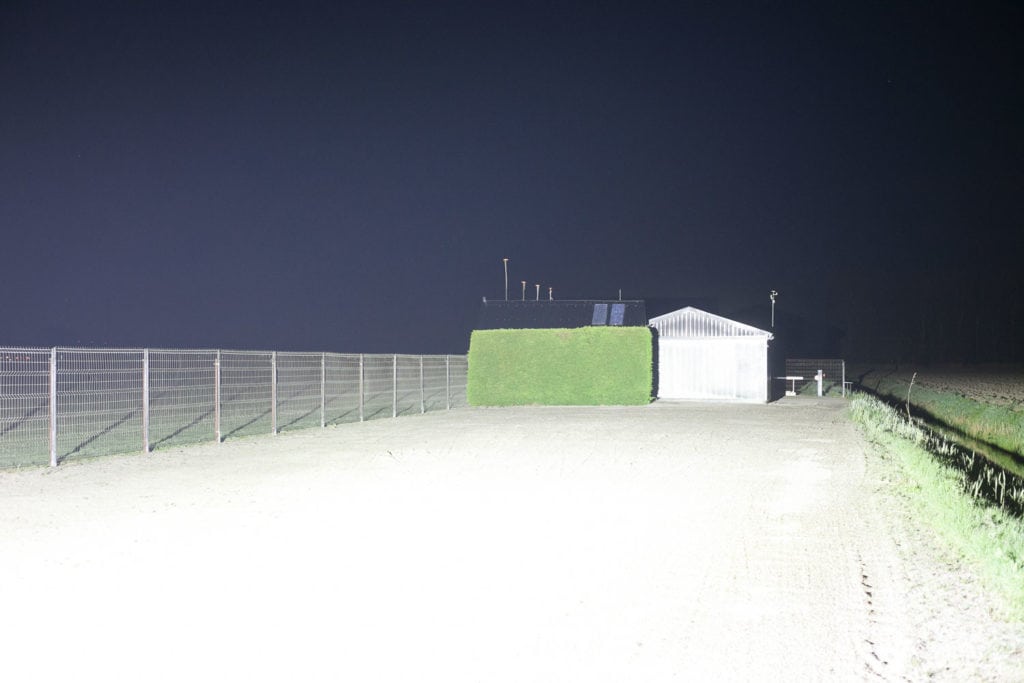
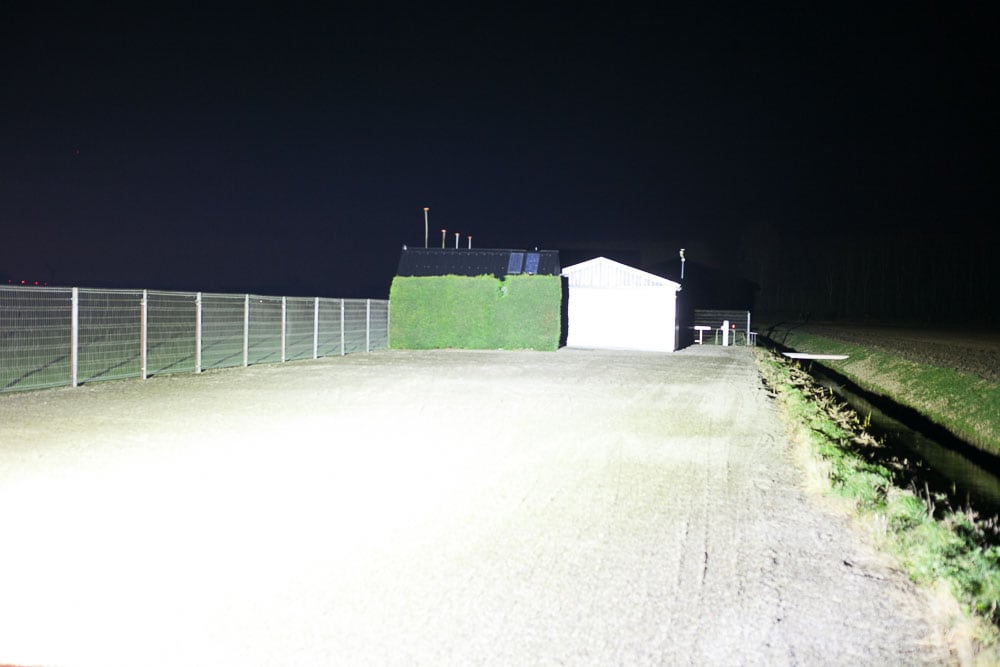
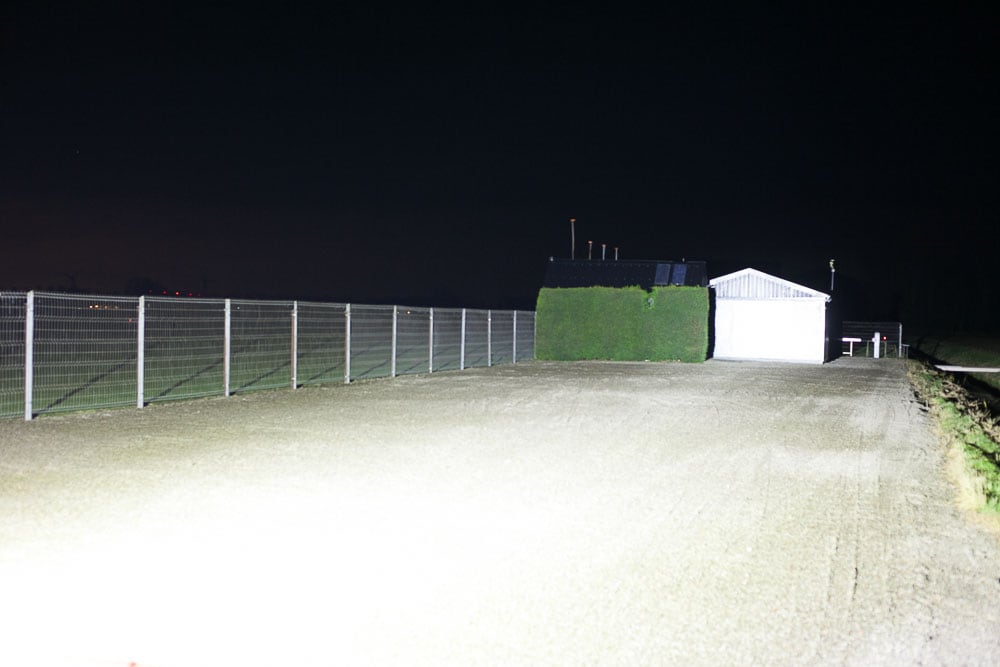
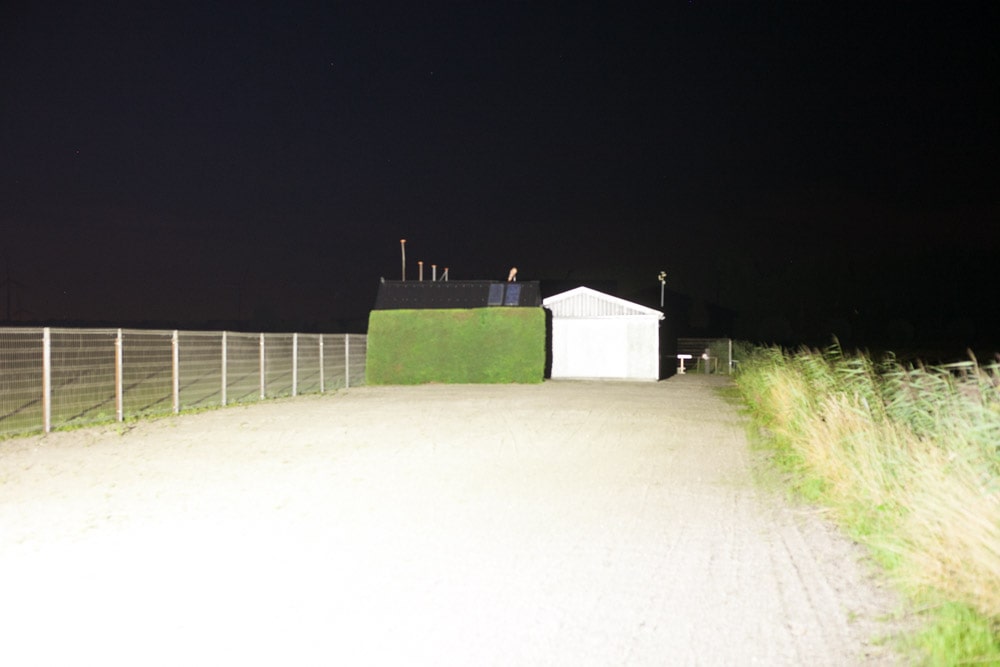
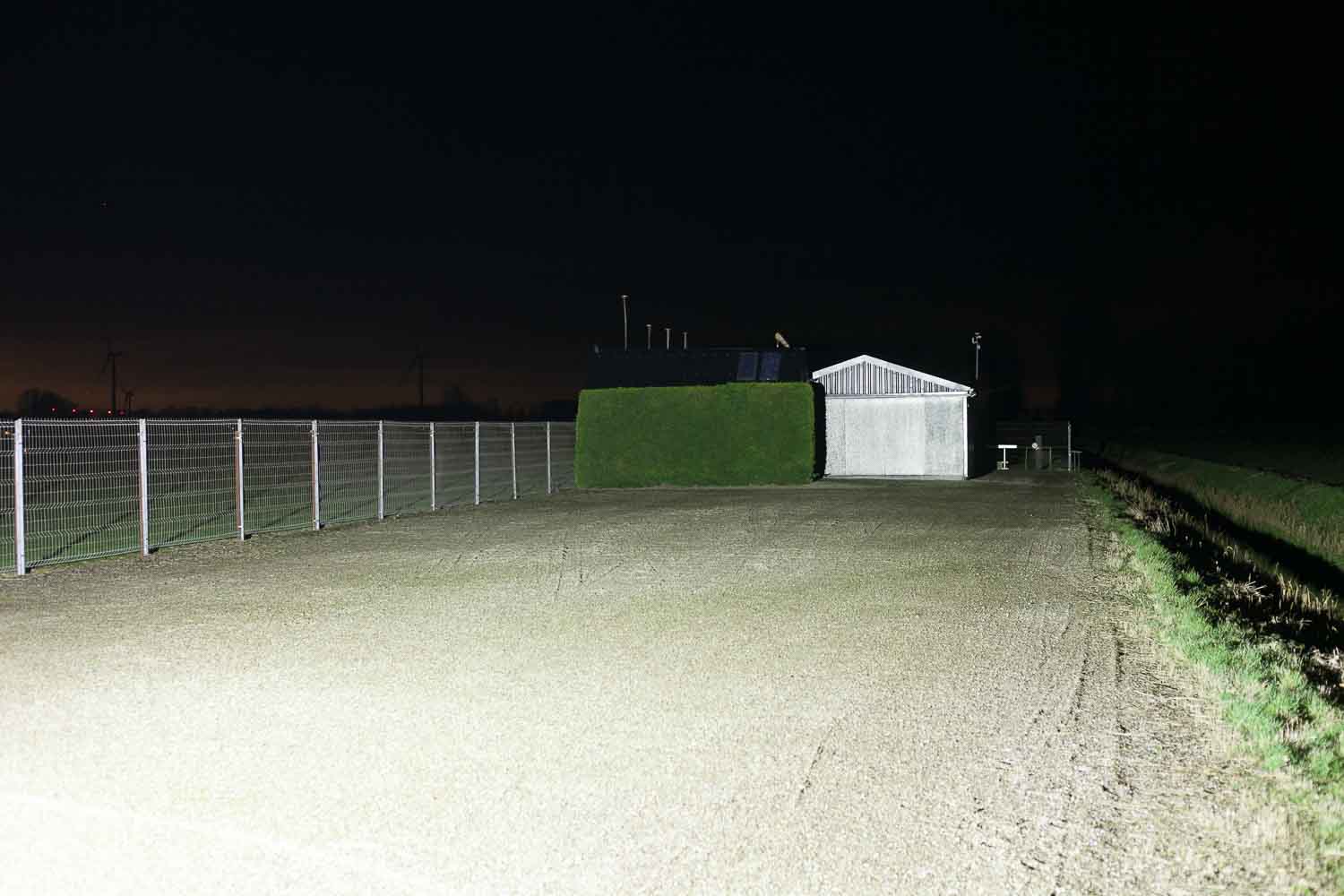
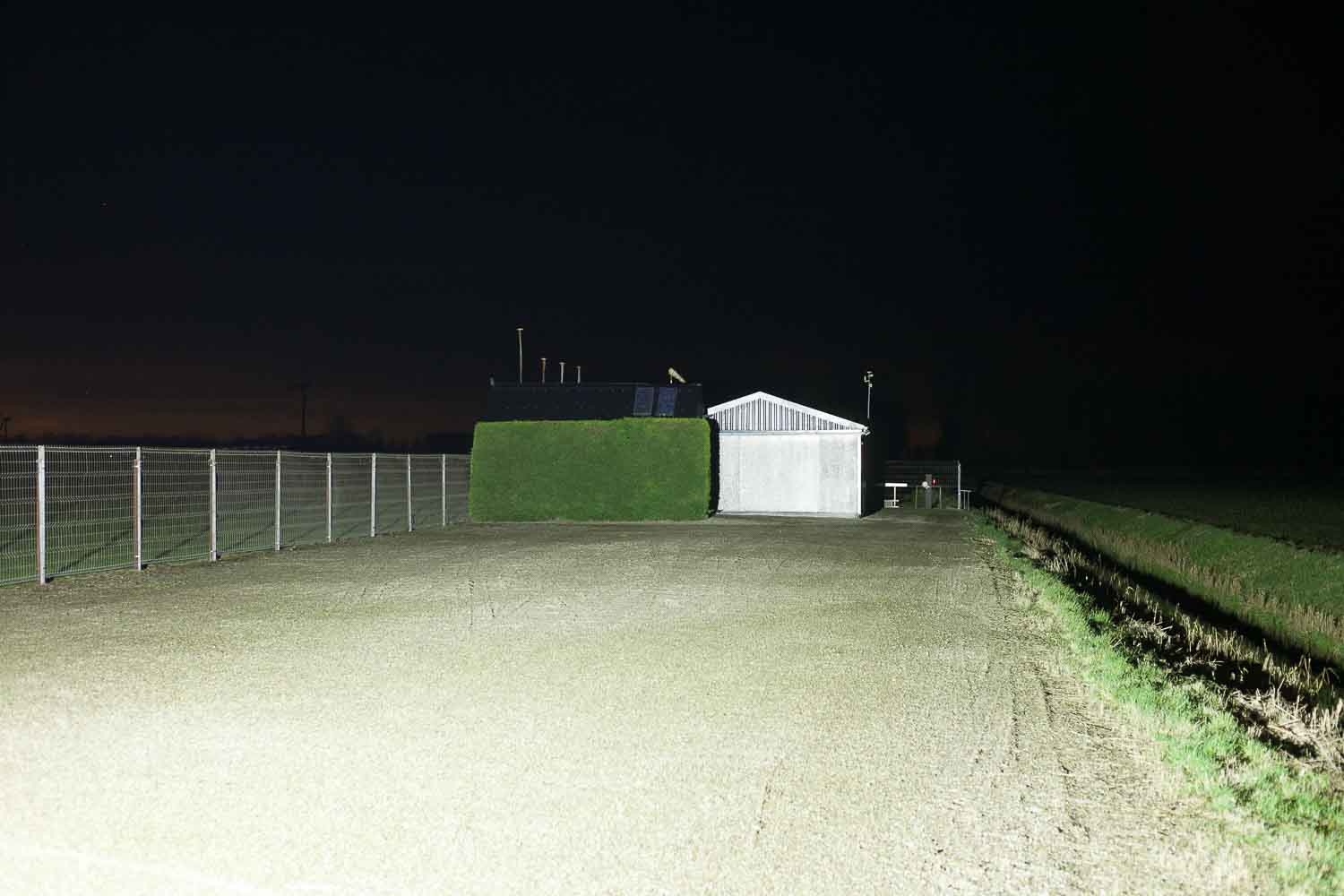







Having the flashlight close to the camera will make the picture reflect all the dirt/fog in the air, and make it like the picture above.
Disclaimer: This flashlight was sent to me for review at no cost by Imalent. I have not been paid to review, nor have I been holding back on problems or defects.
Final Verdict
Pros
- Fans turn on from Middle mode 1 to keep the temperature in check (if you let a 5,000 lumen light run for a long time, it could possibly cook itself)
- Extremely bright!
- Can sustain 10,000+ lumens for the whole runtime
- Fast charging (within 2h 15min fully charged)
Cons
- Switch is hard to find, like on all Imalent MS series flashlights
- No tripod mount
- Not reaching claimed beam distance
- Fans are noisy
- Low mode is a bit high, at 1500 lumens
- It would be better to have the fans regulated by temperature and not just by mode
Explanation on star ratings:
1: Avoid: my phone flashlight would be a better choice – 2: Poor: significant defect or issues; almost unusable – 3: Average: some defects or issues; but still usable 4: Good: recommended (minor issues) – 5: Great: highly recommended
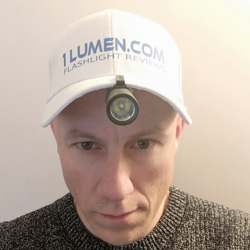
4 stars: ★★★★
For all the pros and cons, I refer you to the lists above. The thing I don’t like is the hard-to-find switch, and the fans not being temperature controlled. That would be a better safety feature IMHO.
The biggest differences between the MS12 and MS12 Mini are of course size and size-lumen ratio. The MS12 Mini can produce over 65,000 lumens at turn on, and a ridiculous high sustained output of over 10,000 lumens, but still, fit in a (large) pocket. That’s quite an achievement.
If you love the Imalent MS18, MS12, or Acebeam X70, but don’t like their size… get the MS12 Mini! It beats all the other soupcan-sized flashlights with ease.
Imalent MS12 Mini discount code
Get yourself an extra 10% off by using our unique 1Lumen discount code: 1Lumen
1lumen selects and reviews products personally. We may earn affiliate commissions through our links, which help support our testing.